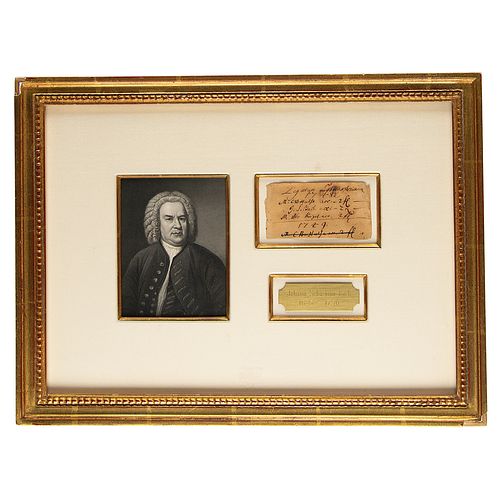Johann Sebastian Bach Document Signed
Two ways to bid:
- Leave a max absentee bid and the platform will bid on your behalf up to your maximum bid during the live auction.
- Bid live during the auction and your bids will be submitted real-time to the auctioneer.
Bid Increments
| Price | Bid Increment |
|---|---|
| $0 | $5 |
| $50 | $10 |
| $200 | $25 |
| $500 | $50 |
About Auction
Nov 9, 2022
RR Auction support@rrauction.com
- Lot Description
Manuscript DS in German , signed “J. S. Bach,” one page, 4 x 2, circa June-July 1748. Receipt headed "Legatum Lobwasserianum, 1748," by which Bach confirms receipt of two guilders from the Lobwasser Bequest at St. Thomas's in Leipzig. Following his signature, Bach writes: "acc[epi] - 2 fl." Above and below Bach's signature, his colleagues Conrad Benedict Hülse and Abraham Kriegel sign for their payment of the same. This sum was paid out around every July 2nd to the cantor, deputy headmaster, and third teacher (tertius) at St. Thomas. It represents one of Bach's several sources of supplementary income which together made up a substantial part of his Leipzig salary, roughly equivalent to an organist's weekly wages. Handsomely mounted, matted, and framed with a portrait and engraved plaque to an overall size of 17 x 13 In fine condition, with even toning, light staining, and slightly chipped edges; two corners of the frame are chipped.
The "Legatum Lobwasserianum," a legacy of 1000 guilders, was bequeathed in 1610 by a Leipzig lawyer's pious widow, Maria Lobwasser; the 50 guilders of annual interest, paid on the Feast of the Visitation, went toward supporting St. Thomas's church and school personnel. This is one of only two known receipts from Bach receiving his Lobwasser funds. The other, from 1750, was originally written on the same sheet of paper underneath the entry for 1748, but the two records were later cut apart and separated.
Curiously, the relevant entry for 1749 must have been made in another, now lost document, as a date "1749" and Hülse's stricken-out signature, apparently made here in error, appear at the bottom of the present slip of paper (formerly between the 1748 and 1750 records). The small octavo leaf, removed from a receipt book, was complete in 1908 when it was offered at C. G. Boerner's sale of 'precious autographs from a Viennese private collection' (lot 3). The buyer was probably the noted Swiss collector Karl Geigy-Hagenbach, in whose 'album of manuscripts by illustrious personages,' published in 1925, it was again illustrated intact. The receipt's location was subsequently unknown until May 1986, when the present upper half of the sheet appeared at Christie's manuscripts sale (lot 271). It was likely acquired there by the Canadian chemist and physician Frederick Lewis Maitland Pattison (1923-2010) and subsequently sold by the New York dealer Kenneth W. Rendell (his description pasted on the reverse of the frame) to the Musée des Lettres et Manuscrits, Paris; acquired from their sale. - Shipping Info
-
Bidder is liable for shipping and handling and providing accurate information as to shipping or delivery locations and arranging for such. RR Auction is unable to combine purchases from other auctions or affiliates into one package for shipping purposes. Lots won will be shipped in a commercially reasonable time after payment in good funds for the merchandise and the shipping fees are received or credit extended, except when third-party shipment occurs. Bidder agrees that service and handling charges related to shipping items which are not pre-paid may be charged to a credit card on file with RR Auction. Successful international Bidders shall provide written shipping instructions, including specified Customs declarations, to RR Auction for any lots to be delivered outside of the United States. NOTE: Declaration value shall be the item’(s) hammer price and RR Auction shall use the correct harmonized code for the lot. Domestic Bidders on lots designated for third-party shipment must designate the common carrier, accept risk of loss, and prepay shipping costs.
-
- Buyer's Premium



 EUR
EUR CAD
CAD AUD
AUD GBP
GBP MXN
MXN HKD
HKD CNY
CNY MYR
MYR SEK
SEK SGD
SGD CHF
CHF THB
THB












